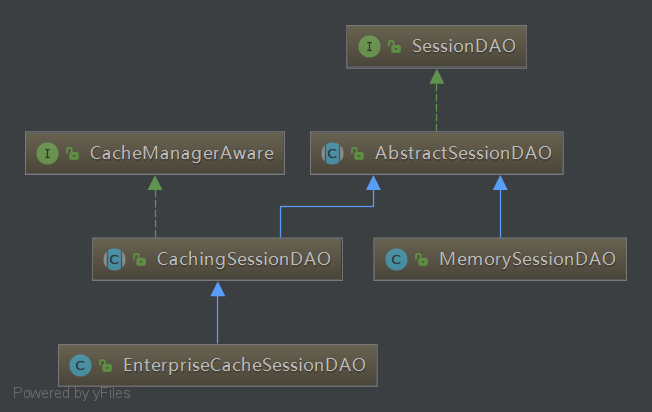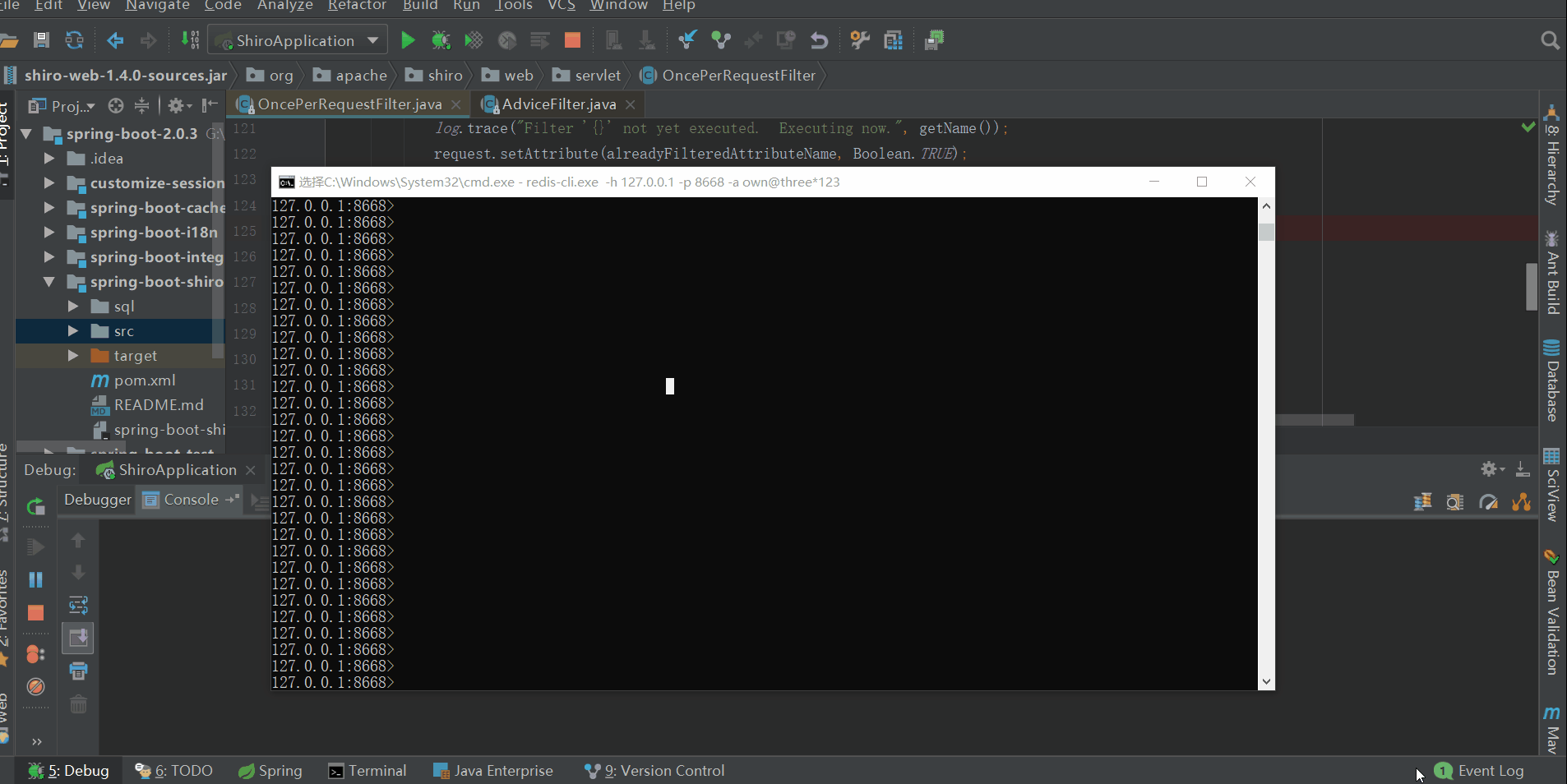shiro源码篇 - shiro的session共享,你值得拥有
前言
开心一刻
老师对小明说:"乳就是小的意思,比如乳猪就是小猪,乳名就是小名,请你用乳字造个句"
小明:"我家很穷,只能住在40平米的乳房"
老师:"..., 这个不行,换一个"
小明:"我每天上学都要跳过我家门口的一条乳沟"
老师:"......, 这个也不行,再换一个"
小明:"老师,我想不出来了,把我的乳头都想破了!"
路漫漫其修远兮,吾将上下而求索!
github:https://github.com/youzhibing
码云(gitee):https://gitee.com/youzhibing
前情回顾
shiro的session创建与session的查询、更新、过期、删除中,shiro对session的操作基本都讲到了,但还缺一个session共享没有讲解;session共享的原理其实在自定义session管理一文已经讲过了,本文不讲原理,只看看shiro的session共享的实现。
为何需要session共享
如果是单机应用,那么谈不上session共享,session放哪都无所谓,不在乎放到默认的servlet容器中,还是抽出来放到单独的地方;
也就是说session共享是针对集群(或分布式、或分布式集群)的;如果不做session共享,仍然采用默认的方式(session存放到默认的servlet容器),当我们的应用是以集群的方式发布的时候,同个用户的请求会被分发到不同的集群节点(分发依赖具体的负载均衡规则),那么每个处理同个用户请求的节点都会重新生成该用户的session,这些session之间是毫无关联的。那么同个用户的请求会被当成多个不同用户的请求,这肯定是不行的。
如何实现session共享
实现方式其实有很多,甚至可以不做session共享,具体有哪些,大家自行去查资料。本文提供一种方式:redis实现session共享,就是将session从servlet容器抽出来,放到redis中存储,所有集群节点都从redis中对session进行操作。
SessionDAO
SessionDAO其实是用于session持久化的,但里面有缓存部分,具体细节我们往下看
shiro已有SessionDAO的实现如下

SessionDAO接口提供的方法如下
package org.apache.shiro.session.mgt.eis; import org.apache.shiro.session.Session;
import org.apache.shiro.session.UnknownSessionException; import java.io.Serializable;
import java.util.Collection; /**
* 从EIS操作session的规范(EIS:例如关系型数据库, 文件系统, 持久化缓存等等, 具体依赖DAO实现)
* 提供了典型的CRUD的方法:create, readSession, update, delete
*/
public interface SessionDAO { /**
* 插入一个新的sesion记录到EIS
*/
Serializable create(Session session); /**
* 根据会话ID获取会话
*/
Session readSession(Serializable sessionId) throws UnknownSessionException; /**
* 更新session; 如更新session最后访问时间/停止会话/设置超时时间/设置移除属性等会调用
*/
void update(Session session) throws UnknownSessionException; /**
* 删除session; 当会话过期/会话停止(如用户退出时)会调用
*/
void delete(Session session); /**
* 获取当前所有活跃session, 所有状态不是stopped/expired的session
* 如果用户量多此方法影响性能
*/
Collection<Session> getActiveSessions();
}
SessionDAO给出了从持久层(一般而言是关系型数据库)操作session的标准。
AbstractSessionDAO提供了SessionDAO的基本实现,如下
package org.apache.shiro.session.mgt.eis; import org.apache.shiro.session.Session;
import org.apache.shiro.session.UnknownSessionException;
import org.apache.shiro.session.mgt.SimpleSession; import java.io.Serializable; /**
* SessionDAO的抽象实现, 在会话创建和读取时做一些健全性检查,并在需要时允许可插入的会话ID生成策略.
* SessionDAO的update和delete则留给子类来实现
* EIS需要子类自己实现
*/
public abstract class AbstractSessionDAO implements SessionDAO { /**
* sessionId生成器
*/
private SessionIdGenerator sessionIdGenerator; public AbstractSessionDAO() {
this.sessionIdGenerator = new JavaUuidSessionIdGenerator(); // 指定JavaUuidSessionIdGenerator为默认sessionId生成器
} /**
* 获取sessionId生成器
*/
public SessionIdGenerator getSessionIdGenerator() {
return sessionIdGenerator;
} /**
* 设置sessionId生成器
*/
public void setSessionIdGenerator(SessionIdGenerator sessionIdGenerator) {
this.sessionIdGenerator = sessionIdGenerator;
} /**
* 生成一个新的sessionId, 并将它应用到session实例
*/
protected Serializable generateSessionId(Session session) {
if (this.sessionIdGenerator == null) {
String msg = "sessionIdGenerator attribute has not been configured.";
throw new IllegalStateException(msg);
}
return this.sessionIdGenerator.generateId(session);
} /**
* SessionDAO中create实现; 将创建的sesion保存到EIS.
* 子类doCreate方法的代理,具体的细节委托给了子类的doCreate方法
*/
public Serializable create(Session session) {
Serializable sessionId = doCreate(session);
verifySessionId(sessionId);
return sessionId;
} /**
* 保证从doCreate返回的sessionId不是null,并且不是已经存在的.
* 目前只实现了null校验,是否已存在是没有校验的,可能shiro的开发者会在后续补上吧.
*/
private void verifySessionId(Serializable sessionId) {
if (sessionId == null) {
String msg = "sessionId returned from doCreate implementation is null. Please verify the implementation.";
throw new IllegalStateException(msg);
}
} /**
* 分配sessionId给session实例
*/
protected void assignSessionId(Session session, Serializable sessionId) {
((SimpleSession) session).setId(sessionId);
} /**
* 子类通过实现此方法来持久化Session实例到EIS.
*/
protected abstract Serializable doCreate(Session session); /**
* SessionDAO中readSession实现; 通过sessionId从EIS获取session对象.
* 子类doReadSession方法的代理,具体的获取细节委托给了子类的doReadSession方法.
*/
public Session readSession(Serializable sessionId) throws UnknownSessionException {
Session s = doReadSession(sessionId);
if (s == null) {
throw new UnknownSessionException("There is no session with id [" + sessionId + "]");
}
return s;
} /**
* 子类通过实现此方法从EIS获取session实例
*/
protected abstract Session doReadSession(Serializable sessionId); }
SessionDao的基本实现,实现了SessionDao的create、readSession(具体还是依赖AbstractSessionDAO子类的doCreate、doReadSession实现);同时加入了自己的sessionId生成器,负责sessionId的操作。
CachingSessionDAO提供了session缓存的功能,如下
package org.apache.shiro.session.mgt.eis; import org.apache.shiro.cache.Cache;
import org.apache.shiro.cache.CacheManager;
import org.apache.shiro.cache.CacheManagerAware;
import org.apache.shiro.session.Session;
import org.apache.shiro.session.UnknownSessionException;
import org.apache.shiro.session.mgt.ValidatingSession; import java.io.Serializable;
import java.util.Collection;
import java.util.Collections; /**
* 应用层与持久层(EIS,如关系型数据库、文件系统、NOSQL)之间的缓存层实现
* 缓存着所有激活状态的session
* 实现了CacheManagerAware,会在shiro加载的过程中调用此对象的setCacheManager方法
*/
public abstract class CachingSessionDAO extends AbstractSessionDAO implements CacheManagerAware { /**
* 激活状态的sesion的默认缓存名
*/
public static final String ACTIVE_SESSION_CACHE_NAME = "shiro-activeSessionCache"; /**
* 缓存管理器,用来获取session缓存
*/
private CacheManager cacheManager; /**
* 用来缓存session的缓存实例
*/
private Cache<Serializable, Session> activeSessions; /**
* session缓存名, 默认是ACTIVE_SESSION_CACHE_NAME.
*/
private String activeSessionsCacheName = ACTIVE_SESSION_CACHE_NAME; public CachingSessionDAO() {
} /**
* 设置缓存管理器
*/
public void setCacheManager(CacheManager cacheManager) {
this.cacheManager = cacheManager;
} /**
* 获取缓存管理器
*/
public CacheManager getCacheManager() {
return cacheManager;
} /**
* 获取缓存实例的名称,也就是获取activeSessionsCacheName的值
*/
public String getActiveSessionsCacheName() {
return activeSessionsCacheName;
} /**
* 设置缓存实例的名称,也就是设置activeSessionsCacheName的值
*/
public void setActiveSessionsCacheName(String activeSessionsCacheName) {
this.activeSessionsCacheName = activeSessionsCacheName;
} /**
* 获取缓存实例
*/
public Cache<Serializable, Session> getActiveSessionsCache() {
return this.activeSessions;
} /**
* 设置缓存实例
*/
public void setActiveSessionsCache(Cache<Serializable, Session> cache) {
this.activeSessions = cache;
} /**
* 获取缓存实例
* 注意:不会返回non-null值
*
* @return the active sessions cache instance.
*/
private Cache<Serializable, Session> getActiveSessionsCacheLazy() {
if (this.activeSessions == null) {
this.activeSessions = createActiveSessionsCache();
}
return activeSessions;
} /**
* 创建缓存实例
*/
protected Cache<Serializable, Session> createActiveSessionsCache() {
Cache<Serializable, Session> cache = null;
CacheManager mgr = getCacheManager();
if (mgr != null) {
String name = getActiveSessionsCacheName();
cache = mgr.getCache(name);
}
return cache;
} /**
* AbstractSessionDAO中create的重写
* 调用父类(AbstractSessionDAO)的create方法, 然后将session缓存起来
* 返回sessionId
*/
public Serializable create(Session session) {
Serializable sessionId = super.create(session); // 调用父类的create方法
cache(session, sessionId); // 以sessionId作为key缓存session
return sessionId;
} /**
* 从缓存中获取session; 若sessionId为null,则返回null
*/
protected Session getCachedSession(Serializable sessionId) {
Session cached = null;
if (sessionId != null) {
Cache<Serializable, Session> cache = getActiveSessionsCacheLazy();
if (cache != null) {
cached = getCachedSession(sessionId, cache);
}
}
return cached;
} /**
* 从缓存中获取session
*/
protected Session getCachedSession(Serializable sessionId, Cache<Serializable, Session> cache) {
return cache.get(sessionId);
} /**
* 缓存session,以sessionId作为key
*/
protected void cache(Session session, Serializable sessionId) {
if (session == null || sessionId == null) {
return;
}
Cache<Serializable, Session> cache = getActiveSessionsCacheLazy();
if (cache == null) {
return;
}
cache(session, sessionId, cache);
} protected void cache(Session session, Serializable sessionId, Cache<Serializable, Session> cache) {
cache.put(sessionId, session);
} /**
* AbstractSessionDAO中readSession的重写
* 先从缓存中获取,若没有则调用父类的readSession方法获取session
*/
public Session readSession(Serializable sessionId) throws UnknownSessionException {
Session s = getCachedSession(sessionId); // 从缓存中获取
if (s == null) {
s = super.readSession(sessionId); // 调用父类readSession方法获取
}
return s;
} /**
* SessionDAO中update的实现
* 更新session的状态
*/
public void update(Session session) throws UnknownSessionException {
doUpdate(session); // 更新EIS中的session
if (session instanceof ValidatingSession) {
if (((ValidatingSession) session).isValid()) {
cache(session, session.getId()); // 更新缓存中的session
} else {
uncache(session); // 移除缓存中的sesson
}
} else {
cache(session, session.getId());
}
} /**
* 由子类去实现,持久化session到EIS
*/
protected abstract void doUpdate(Session session); /**
* SessionDAO中delete的实现
* 删除session
*/
public void delete(Session session) {
uncache(session); // 从缓存中移除
doDelete(session); // 从EIS中删除
} /**
* 由子类去实现,从EIS中删除session
*/
protected abstract void doDelete(Session session); /**
* 从缓存中移除指定的session
*/
protected void uncache(Session session) {
if (session == null) {
return;
}
Serializable id = session.getId();
if (id == null) {
return;
}
Cache<Serializable, Session> cache = getActiveSessionsCacheLazy();
if (cache != null) {
cache.remove(id);
}
} /**
* SessionDAO中getActiveSessions的实现
* 获取所有的存活的session
*/
public Collection<Session> getActiveSessions() {
Cache<Serializable, Session> cache = getActiveSessionsCacheLazy();
if (cache != null) {
return cache.values();
} else {
return Collections.emptySet();
}
}
}
是应用层与持久化层之间的缓存层,不用频繁请求持久化层以提升效率。重写了AbstractSessionDAO中的create、readSession方法,实现了SessionDAO中的update、delete、getActiveSessions方法,预留doUpdate和doDelele给子类去实现(doXXX方法操作的是持久层)
MemorySessionDAO,SessionDAO的简单内存实现,如下
package org.apache.shiro.session.mgt.eis; import org.apache.shiro.session.Session;
import org.apache.shiro.session.UnknownSessionException;
import org.apache.shiro.util.CollectionUtils;
import org.slf4j.Logger;
import org.slf4j.LoggerFactory; import java.io.Serializable;
import java.util.Collection;
import java.util.Collections;
import java.util.concurrent.ConcurrentHashMap;
import java.util.concurrent.ConcurrentMap; /**
* 基于内存的SessionDao的简单实现,所有的session存在ConcurrentMap中
* DefaultSessionManager默认用的MemorySessionDAO
*/
public class MemorySessionDAO extends AbstractSessionDAO { private static final Logger log = LoggerFactory.getLogger(MemorySessionDAO.class); private ConcurrentMap<Serializable, Session> sessions; // 存放session的容器 public MemorySessionDAO() {
this.sessions = new ConcurrentHashMap<Serializable, Session>();
} // AbstractSessionDAO 中doCreate的重写; 将session存入sessions
protected Serializable doCreate(Session session) {
Serializable sessionId = generateSessionId(session); // 生成sessionId
assignSessionId(session, sessionId); // 将sessionId赋值到session
storeSession(sessionId, session); // 存储session到sessions
return sessionId;
} // 存储session到sessions
protected Session storeSession(Serializable id, Session session) {
if (id == null) {
throw new NullPointerException("id argument cannot be null.");
}
return sessions.putIfAbsent(id, session);
} // AbstractSessionDAO 中doReadSession的重写; 从sessions中获取session
protected Session doReadSession(Serializable sessionId) {
return sessions.get(sessionId);
} // SessionDAO中update的实现; 更新sessions中指定的session
public void update(Session session) throws UnknownSessionException {
storeSession(session.getId(), session);
} // SessionDAO中delete的实现; 从sessions中移除指定的session
public void delete(Session session) {
if (session == null) {
throw new NullPointerException("session argument cannot be null.");
}
Serializable id = session.getId();
if (id != null) {
sessions.remove(id);
}
} // SessionDAO中SessionDAO中delete的实现的实现; 获取sessions中全部session
public Collection<Session> SessionDAO中delete的实现() {
Collection<Session> values = sessions.values();
if (CollectionUtils.isEmpty(values)) {
return Collections.emptySet();
} else {
return Collections.unmodifiableCollection(values);
}
} }
将session保存在内存中,存储结构是ConcurrentHashMap;项目中基本不用,即使我们不实现自己的SessionDAO,一般用的也是EnterpriseCacheSessionDAO。
EnterpriseCacheSessionDAO,提供了缓存功能的session维护,如下
package org.apache.shiro.session.mgt.eis; import org.apache.shiro.cache.AbstractCacheManager;
import org.apache.shiro.cache.Cache;
import org.apache.shiro.cache.CacheException;
import org.apache.shiro.cache.MapCache;
import org.apache.shiro.session.Session; import java.io.Serializable;
import java.util.concurrent.ConcurrentHashMap; public class EnterpriseCacheSessionDAO extends CachingSessionDAO { public EnterpriseCacheSessionDAO() { // 设置默认缓存器,并实例化MapCache作为cache实例
setCacheManager(new AbstractCacheManager() {
@Override
protected Cache<Serializable, Session> createCache(String name) throws CacheException {
return new MapCache<Serializable, Session>(name, new ConcurrentHashMap<Serializable, Session>());
}
});
} // AbstractSessionDAO中doCreate的重写;
protected Serializable doCreate(Session session) {
Serializable sessionId = generateSessionId(session);
assignSessionId(session, sessionId);
return sessionId;
} // AbstractSessionDAO中doReadSession的重写
protected Session doReadSession(Serializable sessionId) {
return null; //should never execute because this implementation relies on parent class to access cache, which
//is where all sessions reside - it is the cache implementation that determines if the
//cache is memory only or disk-persistent, etc.
} // CachingSessionDAO中doUpdate的重写
protected void doUpdate(Session session) {
//does nothing - parent class persists to cache.
} // CachingSessionDAO中doDelete的重写
protected void doDelete(Session session) {
//does nothing - parent class removes from cache.
}
}
设置了默认的缓存管理器(AbstractCacheManager)和默认的缓存实例(MapCache),实现了缓存效果。从父类继承的持久化操作方法(doXXX)都是空实现,也就说EnterpriseCacheSessionDAO是没有实现持久化操作的,仅仅只是简单的提供了缓存实现。当然我们可以继承EnterpriseCacheSessionDAO,重写doXXX方法来实现持久化操作。
总结下:SessionDAO定义了从持久层操作session的标准;AbstractSessionDAO提供了SessionDAO的基础实现,如生成会话ID等;CachingSessionDAO提供了对开发者透明的session缓存的功能,只需要设置相应的 CacheManager 即可;MemorySessionDAO直接在内存中进行session维护;而EnterpriseCacheSessionDAO提供了缓存功能的session维护,默认情况下使用 MapCache 实现,内部使用ConcurrentHashMap保存缓存的会话。因为shiro不知道我们需要将session持久化到哪里(关系型数据库,还是文件系统),所以只提供了MemorySessionDAO持久化到内存(听起来怪怪的,内存中能说成持久层吗)
shiro session共享
共享实现
shiro的session共享其实是比较简单的,重写CacheManager,将其操作指向我们的redis,然后实现我们自己的CachingSessionDAO定制缓存操作和缓存持久化。
自定义CacheManager
ShiroRedisCacheManager
package com.lee.shiro.config; import org.apache.shiro.cache.Cache;
import org.apache.shiro.cache.CacheException;
import org.apache.shiro.cache.CacheManager;
import org.springframework.beans.factory.annotation.Autowired;
import org.springframework.stereotype.Component; @Component
public class ShiroRedisCacheManager implements CacheManager { @Autowired
private Cache shiroRedisCache; @Override
public <K, V> Cache<K, V> getCache(String s) throws CacheException {
return shiroRedisCache;
}
}
ShiroRedisCache
package com.lee.shiro.config; import org.apache.shiro.cache.Cache;
import org.apache.shiro.cache.CacheException;
import org.springframework.beans.factory.annotation.Autowired;
import org.springframework.beans.factory.annotation.Value;
import org.springframework.data.redis.core.RedisTemplate;
import org.springframework.stereotype.Component; import java.util.Collection;
import java.util.Set;
import java.util.concurrent.TimeUnit; @Component
public class ShiroRedisCache<K,V> implements Cache<K,V>{ @Autowired
private RedisTemplate<K,V> redisTemplate; @Value("${spring.redis.expireTime}")
private long expireTime; @Override
public V get(K k) throws CacheException {
return redisTemplate.opsForValue().get(k);
} @Override
public V put(K k, V v) throws CacheException {
redisTemplate.opsForValue().set(k,v,expireTime, TimeUnit.SECONDS);
return null;
} @Override
public V remove(K k) throws CacheException {
V v = redisTemplate.opsForValue().get(k);
redisTemplate.opsForValue().getOperations().delete(k);
return v;
} @Override
public void clear() throws CacheException {
} @Override
public int size() {
return 0;
} @Override
public Set<K> keys() {
return null;
} @Override
public Collection<V> values() {
return null;
}
}
自定义CachingSessionDAO
继承EnterpriseCacheSessionDAO,然后重新设置其CacheManager(替换掉默认的内存缓存器),这样也可以实现我们的自定义CachingSessionDAO,但是这是优选吗;如若我们实现持久化,继承EnterpriseCacheSessionDAO是优选,但如果只是实现session缓存,那么CachingSessionDAO是优选,自定义更灵活。那么我们还是继承CachingSessionDAO来实现我们的自定义CachingSessionDAO
ShiroSessionDAO
package com.lee.shiro.config; import org.apache.shiro.session.Session;
import org.apache.shiro.session.mgt.eis.CachingSessionDAO;
import org.springframework.stereotype.Component; import java.io.Serializable; @Component
public class ShiroSessionDAO extends CachingSessionDAO { @Override
protected void doUpdate(Session session) {
} @Override
protected void doDelete(Session session) {
} @Override
protected Serializable doCreate(Session session) {
// 这里绑定sessionId到session,必须要有
Serializable sessionId = generateSessionId(session);
assignSessionId(session, sessionId);
return sessionId;
} @Override
protected Session doReadSession(Serializable sessionId) {
return null;
}
}
最后将ShiroSessionDAO实例赋值给SessionManager实例,再讲SessionManager实例赋值给SecurityManager实例即可
具体代码请参考spring-boot-shiro
源码解析
底层还是利用Filter + HttpServletRequestWrapper将对session的操作接入到自己的实现中来,而不走默认的servlet容器,这样对session的操作完全由我们自己掌握。
shiro的session创建中其实讲到了shiro中对session操作的基本流程,这里不再赘述,没看的朋友可以先去看看再回过头来看这篇。本文只讲shiro中,如何将一个请求的session接入到自己的实现中来的;shiro中有很多默认的filter,我会单独开一篇来讲shiro的filter,这篇我们先不纠结这些filter。
OncePerRequestFilter中doFilter方法如下
public final void doFilter(ServletRequest request, ServletResponse response, FilterChain filterChain)
throws ServletException, IOException {
String alreadyFilteredAttributeName = getAlreadyFilteredAttributeName();
if ( request.getAttribute(alreadyFilteredAttributeName) != null ) { // 当前filter已经执行过了,进行下一个filter
log.trace("Filter '{}' already executed. Proceeding without invoking this filter.", getName());
filterChain.doFilter(request, response);
} else //noinspection deprecation
if (/* added in 1.2: */ !isEnabled(request, response) ||
/* retain backwards compatibility: */ shouldNotFilter(request) ) { // 当前filter未被启用或忽略此filter,则进行下一个filter;shouldNotFilter已经被废弃了
log.debug("Filter '{}' is not enabled for the current request. Proceeding without invoking this filter.",
getName());
filterChain.doFilter(request, response);
} else {
// Do invoke this filter...
log.trace("Filter '{}' not yet executed. Executing now.", getName());
request.setAttribute(alreadyFilteredAttributeName, Boolean.TRUE); try {
// 执行当前filter
doFilterInternal(request, response, filterChain);
} finally {
// 一旦请求完成,我们清除当前filter的"已经过滤"的状态
request.removeAttribute(alreadyFilteredAttributeName);
}
}
}

上图中,我可以看到AbstractShiroFilter的doFilterInternal放中将request封装成了shiro自定义的ShiroHttpServletRequest,将response也封装成了shiro自定义的ShiroHttpServletResponse。既然Filter中将request封装了ShiroHttpServletRequest,那么到我们应用的request就是ShiroHttpServletRequest类型,也就是说我们对session的操作最终都是由shiro完成的,而不是默认的servlet容器。
另外补充一点,shiro的session创建不是懒创建的。servlet容器中的session创建是第一次请求session(第一调用request.getSession())时才创建。shiro的session创建如下图

此时,还没登录,但是subject、session已经创建了,只是subject的认证状态为false,说明还没进行登录认证的。至于session创建过程已经保存到redis的流程需要大家自行去跟,或者阅读我之前的博文
总结
1、当以集群方式对外提供服务的时候,不做session共享也是可以的
可以通过ip_hash的机制将同个ip的请求定向到同一台后端,这样保证用户的请求始终是同一台服务处理,与单机应用基本一致了;但这有很多方面的缺陷(具体就不详说了),不推荐使用。
2、servlet容器之间做session同步也是可以实现session共享的
一个servlet容器生成session,其他节点的servlet容器从此servlet容器进行session同步,以达到session信息一致。这个也不推荐,某个时间点会有session不一致的问题,毕竟同步过程受到各方面的影响,不能保证session实时一致。
3、session共享实现的原理其实都是一样的,都是filter + HttpServletRequestWrapper,只是实现细节会有所区别;有兴趣的可以看下spring-session的实现细节。
4、如果我们采用的spring集成shiro,其实可以将缓存管理器交由spring管理,相当于由spring统一管理缓存。
5、shiro的CacheManager不只是管理session缓存,还管理着身份认证缓存、授权缓存,shiro的缓存都是CacheManager管理。但是身份认证缓存默认是关闭的,个人也不推荐开启。
6、shiro的session创建时机是在登录认证之前,而不是第一次调用getSession()时。
参考
《跟我学shiro》
最新文章
- Unity粒子系统特性
- Oracle的表空间和数据文件
- JavaScript 对象 之继承对象 学习笔记
- 使用HttpClient抓取网站首页
- Python3基础 type获取变量的类型
- OSGi 对软件复杂度的影响
- CentOS安装crontab及使用方法
- 【HDOJ】1254 推箱子
- 《University Calculus》-chape6-定积分的应用-求体积
- Android方法的传递值及其改变
- 在asp.net页面上按回车会触发Imagebutton控件的Click事件
- Object.defineproperty实现数据和视图的联动 ------是不是就是 Angular 模型和视图的同步的实现方式???
- 使用grunt实现web自动化
- Mego开发文档 - 建模高级主题
- Linux IPC - Shared memory
- servlet进行用户名和密码校验
- java 开发 websocket 网页端聊天室
- mybatis generator的maven插件,找不到properties的配置文件错误的解决
- HDU 4786 Fibonacci Tree 最小生成树
- 迭代器模式(Iterator)